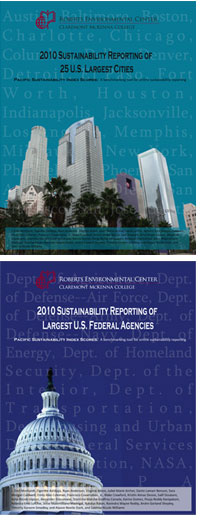 Using data collected from U.S. federal agency and city Web sites during spring 2010, the Roberts Environmental Center (REC) at Claremont McKenna College has released an analysis of environmental and social sustainability reporting of the largest U.S. federal agencies and the 25 largest U.S. cities. Making the top of the federal agency list with an A+' grade is the Department of Energy, followed closely by the Department of Homeland Security, which also scored an A+', and the Department of Defense: Navy, which ranked third with a solid A.' On the list of largest cities, Phoenix topped the rankings with an A+', followed by Los Angeles, which also earned an A+', and New York, which was graded an A.'
Using data collected from U.S. federal agency and city Web sites during spring 2010, the Roberts Environmental Center (REC) at Claremont McKenna College has released an analysis of environmental and social sustainability reporting of the largest U.S. federal agencies and the 25 largest U.S. cities. Making the top of the federal agency list with an A+' grade is the Department of Energy, followed closely by the Department of Homeland Security, which also scored an A+', and the Department of Defense: Navy, which ranked third with a solid A.' On the list of largest cities, Phoenix topped the rankings with an A+', followed by Los Angeles, which also earned an A+', and New York, which was graded an A.'
Environmental scoring looked at an organization's transparency with regard to such topics as emissions, energy sources and consumption, environmental incidents and violations, materials, mitigations and remediation, waste, and water usage. The social reporting considered such factors as an agency's financials, employees, safety, social management organization, social vision and commitment, policy and certifications, social initiatives and mitigations, and social goals and targets.
The goal of this analysis conducted by the Roberts Environmental Center is to acquaint the undergraduate students doing the analysis with environmental and social issues facing American cities and federal agencies, and the ways in which they approach and resolve these issues. It is hoped that the analysis will encourage the cities and federal agencies to increase environmental and social transparency.
According to Dr. Emil Morhardt, Director of the Roberts Environmental Center, social intent and reporting scores were higher for federal agencies than for corporations of similar size that are the focus of much of the Center's analytical activities, with only a third of the agencies receiving a grade lower than B'. The social categories with the lowest reporting were human rights and health and safety topics. By contrast, environmental reporting overall was particularly low, with more than half of the agencies receiving a C' or lower. Only a fourth of the agencies addressed any amount of quantitative data on emissions, waste, water usage, energy usage, and environmental incidents and violations.
Grades for U.S. cities were moderate, with only three out of the 25 cities receiving grades lower than C' in environmental reporting. The least reported environmental categories were environmental violations, environmental fines, and waste (including hazardous waste) and quantitative data. Social intent and reporting scores were similar; most cities received a C' or higher in the former, and only three out of the 25 received lower than a C' in the latter.
Additional findings in both studies:
The Dept. of Energy led the sector, but with a stronger focus in social reporting and social performance scores, which are mostly ethical and human rights topics.
The Dept. of Homeland Security's notable efforts included reducing environmental impact at operation sites.
Although the Dept. of Defense: Navy, ranked third overall, it ranked first in environmental reporting, presenting a substantial amount of information on environmental initiatives throughout its website.
While New York ranked third among the largest U.S. cities, it led the sector in social reporting. For example, the city noted its plans to assist community families with daycare, by implementing home-based, after-school programs.
San Jose placed fifth overall, yet led the sector in environmental intent and reporting. The city's mission addresses the implementation of a zero-waste policy, energy reduction by 50%, and complete, renewable energy by 2022.
The full reports for both sectors are available online:
U.S. Federal Agencies
Largest U.S. Cities
Sustainability Reporting of the Largest U.S. Federal Agencies:
A+ Dept. of Energy (USA)
A+ Dept. of Homeland Security (USA)
A Dept. of Defense--Navy (USA)
B+ Dept. of Transportation (USA)
B+ General Services Administration (USA)
B+ NASA (USA)
B Dept. of Agriculture (USA)
B Dept. of Defense--Army (USA)
B- USEPA (USA)
B- Dept. of the Interior (USA)
B- Dept. of Defense--Air Force (USA)
C+ Dept. Housing and Urban Dev. (USA)
Sustainability Reporting of the 25 U.S. Largest Cities
A+ Phoenix
A+ Los Angeles
A New York
A Austin
A San Jose
A- Boston
A- Houston
B+ San Diego
B+ Chicago
B+ San Antonio
B+ Columbus
B Seattle
B Denver
B Baltimore
B Fort Worth
B Philadelphia
B- El Paso
B- Milwaukee
B- San Francisco
B- Jacksonville
C+ Indianapolis
C+ Charlotte
C+ Dallas
C Detroit
C- Memphis
About Roberts Environmental Center
The Roberts Environmental Center is an environmental research institute at Claremont McKenna College located in Claremont, Calif. Its mission is to provide students with a comprehensive and realistic understanding of today's environmental issues and the ways in which these issues are being and can be resolved, beyond the confines of traditional academic disciplines and curriculum. The Center strives to identify, publicize, and encourage policies and practices that achieve economic and social goals in the most environmentally benign and protective manner.
Roberts Environmental Center
Sustainability Reports Released for
Federal Agencies and Cities
Topics
Contact
Office of Strategic Communications & Marketing
400 N. Claremont Blvd.
Claremont, CA 91711
Phone: (909) 621-8099
Email: [email protected]
Media inquiries: CMC Media
Email: [email protected]
